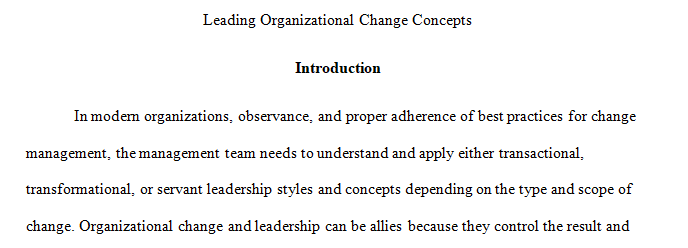
Analysis of Organizational Leadership Theory and Practice
Leading Organizational Change Concepts
Analysis of Organizational Leadership Theory and Practice
Students will engage in a critical analysis of leadership theory and practice, based on readings from Part 1 and Part II (Chapters 1-4) of the text-Hickman, G.R. (2010).Leading Change in Multiple Contexts.Los Angeles, CA: Sage Publications. ISBN: 978-1-4129-2678-2. My primary concern with this analysis paper is that students engage materials in ways that demonstrate at least three dimensions:
First, students should demonstrate strong engagement with theories and concepts from the book chapters and readings
Second, students should engage these materials critically (what is working, what is not; what are strengths and what are limitations).
Third, students should feel free to explore a variety of ideas that relate to change (what does thinking outside the box really look like?).
Instructions:
Please choose 3-4 concepts to focus on for your mini-analysis. These concepts can come from anywhere within Parts I and Part II of the text.
Introduce and explain the concepts; at minimum, bring in at least 1 other scholarly/academic reference or citation per concept that you have introduced.
Link the concepts to current or past events for further analysis (for example can you think of a time when an organization, leader etc. has exhibited these concepts, explain)
Make sure to include a reference page and reference the text. Again, you will want to bring in external citations and references to strengthen your paper; a minimum of three external references is expected.
You must include 3-4 scholarly citations in addition to your text book for this paper.
Paper will generally be between 4-5 pages. Maximum 5 pages (Title page and reference page are not included in this count).
These somewhat broad instructions for paper one, are intended to give students great latitude in how they approach the assignment: critical analysis structure, compare and contrast dominate theories, development of an innovative leadership approach, etc. However, without detailed and consistent references to readings from this class, the paper will not receive a passing grade.
Structure:
Make sure that the paper has a well-developed structure and engages reading materials from this class. One of the biggest challenges for students is creating their own analytic structure with a clear purpose or goal. The structure or organization of the paper should include:
- Introduction that:
- a) establishes interest
- b) establishes the topic of focus
- c) provides a clear thesis statement (goal or purpose followed by a brief justification of its importance)
- d) a preview of central points or organization of the body of the paper.
- In the body of the paper, students should think of each first sentence of a paragraph as a “mini-thesis” that establishes the goal or direction of the paragraph. This first sentence is often an argument, position, or strong “stand alone” statement. By stand-alone statement I mean an idea that makes sense on its own.
- Conclusion–summarized key ideas (sometimes this is a summary of key points learned or suggests directions for future analysis).
***Please DO NOT use materials from John Kotter’s leadership books. I want students to write papers that integrate key ideas from our text. Google Scholar is an excellent resource for scholarly work.
Subject: Masters Management
https://sk.sagepub.com/books/leading-change-in-multiple-contexts
Click table of contents and read chapters 1-4
Answer preview…………………………
 apa 1438 words
apa 1438 words